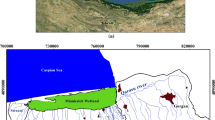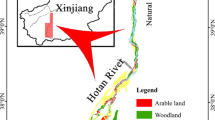Abstract
In many vulnerable wetlands, water is the most crucial factor for sustaining human development, economic growth, as well as existence and evolution of various indigenous ecosystems. This has led to intensive competitions against limited water resources and caused a number of potentially adverse effects on local ecosystems and human society. As water demand by human activities is increasing, balancing water demands between human society and ecosystems is desired to improve economic development without causing too much disturbance on the environment and ecosystems within a wetland. In this study, a computationally efficient quantitative method was developed to calculate the ecological flow requirement (i.e., water demand by ecosystems) in an alpine wetland of western China. The proposed method was also carried out by means of remote sensing images interpretation. Through this method, variations in water demands by human beings and ecosystems could be reflected and analyzed, which would be useful in helping formulate water allocation strategies under multiple objectives such as environmental protection, economic development, and ecological conservation. The method was then applied to assess ecological flow requirements in Zoige Wetland of western China. The results indicated that to maintain the basic ecological structure and integrity of the wetlands, the minimum reserve of 6.218 billion m3/a and a suitable reserve of 6.639 billion m3/a of water would be required. Also, the application results indicated that the method is applicable and can be expanded to other similar wetlands for balancing water demands between ecosystems and human beings.







Similar content being viewed by others
References
Chen H, Zhao YW (2011) Evaluating the environmental flows of China’s Wolonghu wetland and land use changes using a hydrological model, a water balance model, and remote sensing. Ecol Model 222(2):253–260
Cheng GW, Chen GR (2003) Study on the evapotranspiration simulation of sub-alpine forest area in Gongga Mountain. Adv Water Sci 14(5):617–621 (in Chinese)
Cui BS, Tang N, Zhao XS (2009) A management-oriented valuation method to determine ecological water requirement for wetlands in the Yellow River Delta of China. J Nat Conserv 17(3):129–141
Cui BS, Hua YY, Wang CF (2010) Estimation of ecological water requirements based on habitat response to water level in Huanghe River Delta, China. Chin Geogr Sci 20(4):318–329
Gordon ND, McMahon TA, Finlayson BL (2004) Stream hydrology: an introduction for ecologists. Wiley, New York, p 429
He YT, Li WH, Li GC (2004) Ecological water requirement of forests in Loess Plateau. Environ Sci 25(3):35–39 (in Chinese)
Hughes DA, Hannart P (2003) A desktop model used to provide initial estimate of the ecological instream flow requirement of rivers in South Africa. J Hydrol 70:167–181
James JM, Ariel D, Richard EH (2009) The design of water markets when instream flows have value. J Environ Manag 90(2):1089–1096
Kashaigili JJ, Mccartney M, Mahoo HF (2007) Estimation of environmental flows in the Great Ruaha River Catchment, Tanzania. Phys Chem Earth 32:1007–1014
King JM, Tharme RE, De Villiers MS (eds) (2002) Environmental flow assessments for rivers: manual for the building block methodology. Water Research Commission, Pretoria: Water Research Commission Technology Transfer Report
Li LJ, Li JY, Liang LQ (2009) Method for calculating ecological water storage and ecological water requirement of marsh. J Geogr Sci 19:427–436
Liu CM, Wang LX, Xia J (2004) Research on the regional configuration of eco-environmental construction and the ecological water requirement in Northwest China, research on the water resource allocation, eco-environmental construction and strategy of sustainable development: volume of eco-environment. Science Press, Beijing, pp 34–38 (in Chinese)
Liu WC, Liu SY, Hsu MH (2005) Water quality modeling to determine minimum instream flow for fish survival in tidal rivers. J Environ Manag 76(4):293–308
Miao H, Wei YC, Jiang LJ (2003) Ecological water use and the estimate method. Acta Ecologica Sinica 23(6):1157–1164 (in Chinese)
Min QW, Geng YH (2005) Estimation and analysis of ecological water requirement in the Jinghe watershed. Resour Sci 27(4):14–17 (in Chinese)
Orth DJ, Leonard PM (1990) Comparison of discharge methods and habitat optimization for recommending instream flows to protect fish habitat. Regul Rivers Res Manag 5:129–138
Pang AP, Li CH, Wang X (2010) Land use/cover change in response to driving forces of Zoige County, China. In: Proceedings of the 10th International Conference on Ecological Informatics and Ecosystem Conservation, pp 1161–1169
Qian ZY, Zhang GD, Wang DZ (2000) Strategic research on sustainable development of water resource in China. Chin Acad Eng 2(8):1–17 (in Chinese)
Qiu PF, Wu N, Luo P (2009) Analysis of dynamics and driving factors of wetland landscape in Zoige, Eastern Qinghai-Tibetan Plateau. J Mt Sci 42(1):42–55
Rebelo LM, Finlayson CM, Nagabhatla N (2009) Remote sensing and GIS for wetland inventory, mapping and change analysis. J Environ Manag 90(7):2144–2153
Rossell IM, Moorhead KK, Alvarado H (2009) Succession of a Southern Appalachian Mountain Wetland six years following hydrologic and microtopographic restoration. Restor Ecol 17(2):205–214
Schneider N, Eugster W (2007) Climatic impacts of historical wetland drainage in Switzerland. Clim Change 80:301–321
Sisto NP (2009) Environmental flows for rivers and economic compensation for irrigators. J Environ Manag 90(2):1236–1240
Tan Q, Huang GH, Cai YP (2009) Design of an inexact fuzzy robust programming model for integrated evacuation management under uncertainty. J Urban Plann Dev 135(1):39–49
Tan Q, Huang GH, Cai YP (2010a) Municipal solid waste management with recourse: an inexact dynamic programming model containing fuzzy boundary intervals in objectives and constraints. J Environ Manag 91(9):1898–1913
Tan Q, Huang GH, Cai YP (2010b) Identification of optimal plans for solid waste management in an environment of fuzziness and two-layer randomness. Stoch Environ Res Risk Assess 24(1):147–164
Tennant DL (1976) Instream flow regimens for fish, wildlife, recreation and related environmental resources. Fisheries 1(4):6–10
Tharme RE (2003) A global perspective on environmental flow assessment: emerging trends in the development and application of environmental flow methodologies for rivers. River Res Appl 19:397–441
Tu XY, Wu TS, Wang S (2009) Research on eco-environmental water requirement for main rivers in Haihe Basin. J Arid Land Resour Environ 23(5):65–71 (in Chinese)
Wadeson RA, Rowntree KM (1998) Application of hydraulic biotope concept to the classification of instream habitats. Aquat Ecosyst Health Manag 1:143–157
Wang LX (2000) Vegetative eco environment construction and water use of eco environment-taking northwestern area for an example. Res Soil Water Conserv 7(3):5–7 (in Chinese)
Wang ZX (2005) Using the modified Tennant method worked on water demand of ecological environment for middle and small river in high and cold area. J Heilongjiang Hydraul Eng Coll 32(4):100–103 (in Chinese)
Yan ZL, Wu N (2005) Rangeland privatization and its impacts on the Zoige wetlands on the eastern Tibetan Plateau. J Mt Sci 2(2):105–115
Yang FM, Zhong FY (1994) Feedback effect of Zoige alpine’s environment to the nutrition composition of marsh vegetation. J Sichuan Grassl, pp 23–26 (in Chinese)
Yang ZF, Cui BS, Liu JL (2005) Estimation methods of eco-environmental water requirements: case study. Sci China Ser D 48(8):1280–1292
Yong GW, Shi CC, Qiu PF (2003) Remote sensing monitoring of sand expansion at fragile grassland ecosystem in Ruoergai Plateau, Sichuan, China. J Mt Sci 21(6):758–762 (in Chinese)
Zuo QT (2002) Study on vegetation ecological use for water resources in arid and semiarid region. J Soil Water Conserv 16(3):114–118 (in Chinese)
Acknowledgments
This research was supported by the National Key Technologies R&D Program (No. 2007BAC18B01) and the Program for ChangJiang Scholars and the Innovative Research Team at University (No. IRT0809). The authors would like to extend special thanks to the editor and the reviewer for their constructive comments and suggestions in improving the quality of this paper.
Author information
Authors and Affiliations
Corresponding author
Rights and permissions
About this article
Cite this article
Tan, Yy., Wang, X., Li, Ch. et al. Estimation of ecological flow requirement in Zoige Alpine Wetland of southwest China. Environ Earth Sci 66, 1525–1533 (2012). https://doi.org/10.1007/s12665-011-1392-2
Received:
Accepted:
Published:
Issue Date:
DOI: https://doi.org/10.1007/s12665-011-1392-2




